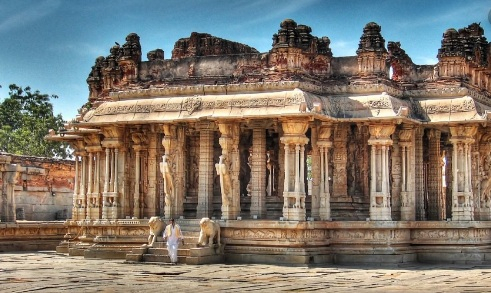
India, the land of millions of gods and goddesses, has an incredible heritage to boast about, which not only leaves people in awe but affirms the belief that the land of wonders was truly a talent in the ancient times.
The heritage sites of the country are excellent examples of the infinite knowledge of Indian artisans who were talented much beyond their times. The musical pillars in the temples of South India, which sing to different tunes altogether, are one of the examples of the incredible beauty of India.
Even today, tourists are awe-struck by the sound of these tapping and the blowing pillars -- the two kinds of musical pillars found in these temples. While tapping pillars make a sound when tapped, you hear the tunes of the flute as you blow air in the holes the blowing pillars.
Many temples such as the Vijaya Vittala Temple in Hampi, Nellaiappar Temple, Alwar Tirunagari Temple, Lepakshi in Andhra Pradesh, and Adi Kumbareswarar Temple are living examples of such resounding monuments.
One of the prominent features of the Vijaya Vittala Temple in Hampi is the musical pillars, which support the roof of the temple. A trip to Hampi is a must to explore the monument of the 15th-century temple that leaves tourists in awe of its architect, particularly the seven thin pillars which circulate one thick post at the center.
The Nellaiappar Temple, one of the most prominent temples in South India, boasts the incredible musical pillars, with each of them making a different sound. The 7th-century temple is known for its elegant and exotic carvings and located in Tirunelveli of Tamil Nadu.
The 48 small cylindrical pillars of varying girth around a central pillar produce different sounds when tapped. There are sympathetic vibrations from the neighboring pillars when one of them is tapped.
Center for various cultural activities and located in Madurai, the Meenakshi Amman Temple's musical pillars were carved for the purpose of playing prayers to the god, as well as, for cultural events.
The ancient temple -- considered one of the 100 wonders of the world -- has five musical pillars located just outside the thousand-pillared hall which increase its masterpiece architecture's charm to many folds, cites official government website on Tirunelveli district.
Apart from many other attractions, a large central pillar surrounded by 22 small pillars is just another marvel of ancient Indian artisans, which is also affirmed in the form of thousands of statues.
Similarly, the Alwar Tirunagari Temple -- the famous Vishnu temple in Tamil Nadu – boasts both the tapping and the blowing pillars, which are one of the principal elements of this temple built during the time of Pandya kings.
The stone nadaswaram (double-reed wind instrument) is another interesting feature of the temple in the town of Alwar Tirunagari.
You can see musical pillars at many other temples in South India, including the Thanumalayam Temple where visitors are welcomed with the sound of saptha swarangal – key seven notes of music – from four musical pillars.
In an analysis of the rock sample from the pillars by the geology department of Presidency college in Chennai, Geology Professor Dr. Subramanina found that Silica-rich rock was fairly abundant in Hospet near Hampi.
The tourists at many of these sites have however been restricted from touching these standing testimonies to Hindu art to preserve these unique heritage structures.









